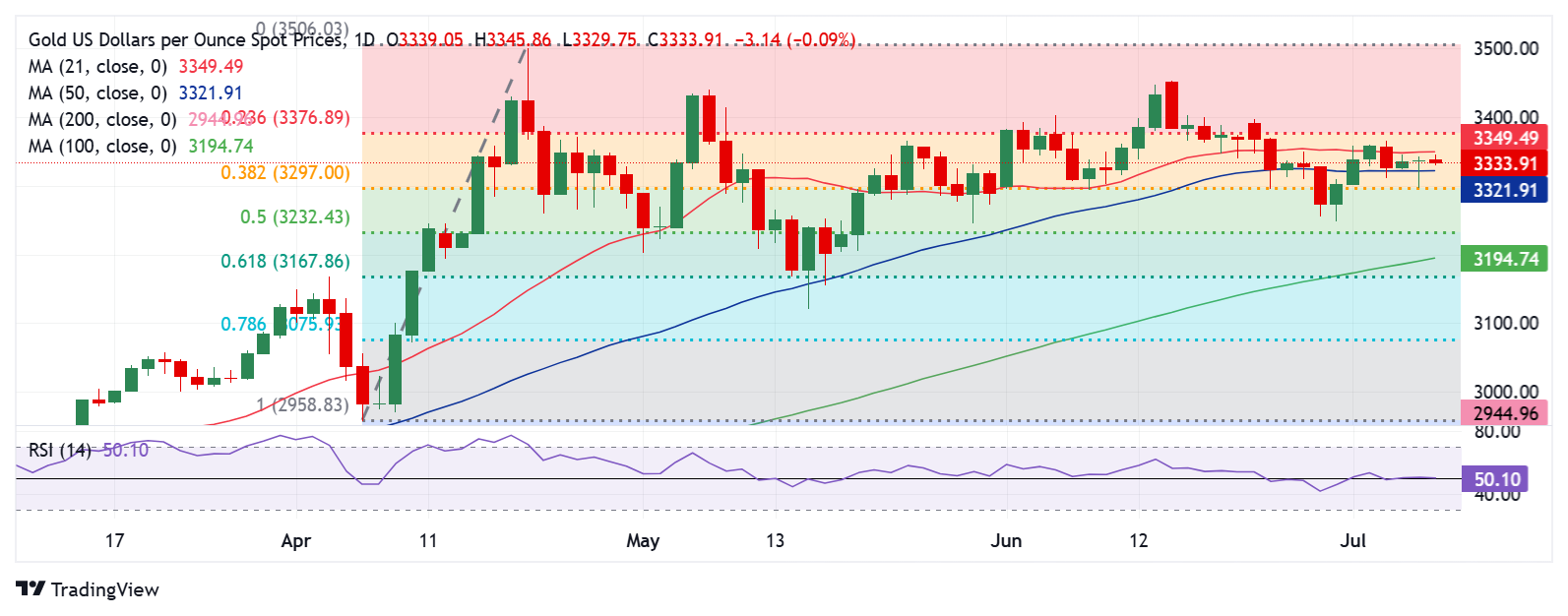
- Gold price turns south early Tuesday but remains in a familiar range below $3,350.
- US Dollar reverses the previous upswing alongside US Treasury bond yields as traders assess Trump’s latest tariffs.
- Gold price closes Monday above 50-day SMA but sellers lurk at 21-day SMA amid a neutral daily RSI.
Gold price is back in the red below $3,350 early Tuesday, remaining stuck in a familiar range since last Friday as investors assess the implications of the latest tariff threats by US President Donald Trump.
Gold price remains at the mercy of tariff talks, US Dollar
US President Donald Trump announced on social media on Monday that 25% tariffs will be imposed on imports from Japan and the Republic of Korea, respectively, beginning August 1.
Later, he announced that similar letters were sent to the leaders of 12 other countries, informing them that tariffs ranging 25% to 40% will be charged starting next month.
Risk sentiment took a further hit on Trump’s announcements, fuelling a fresh rebound in the traditional safe-haven Gold price as the renewed tariff threats revived trade war fears globally.
Gold price bounced off five-day lows of $3,297 and recovered to near $3,350 but its renewed upside was capped by the resurgent US Dollar demand as a safe-haven.
The Greenback got an additional boost from a big rally in the USD/JPY pair as the Japanese Yen fell hard on Trump’s 25% tariffs announcement on Japan.
Further, the US Treasury bond yields firmed up on expectations that the US Federal Reserve (Fed) will stand pat on interest rates for an extended period if fresh tariffs stoke inflationary fears.
This narrative also aided the buck’s turnaround while the non-interest-bearing Gold price’s recovery.
In Tuesday’s trading so far, Gold sellers have made a comeback as trade concerns continue to cast a cloud on the US economic and inflation outlook, backing the case for an extended pause by the Fed.
However, the Gold price downside appears cushioned as a lack of certainty on the US tariff plans continues to keep investors scurrying for safety in the bright metal while the US Dollar faces headwinds amid renewed worries over the economic prospects if a trade war kick starts.
When asked if the trade negotiations deadline, extended until August 1, was firm, Trump said: “I would say firm, but not 100% firm. If they call up and they say we’d like to do something a different way, we’re going to be open to that.”
Heightened uncertainty around Trump’s tariff plans will continue to keep a floor under Gold price.
In the absence of any top-tier US economic data releases, tariff updates will likely keep Gold traders entertained as they eagerly await the release of the Fed’s June meeting Minutes on Wednesday.
Gold price technical analysis: Daily chart

Gold price remains confined in a narrow range, with the 21-day Simple Moving Average (SMA) at $3,350 acting as a tough nut to crack for buyers.
Meanwhile, the 50-day SMA at $3,322 continues to guard the downside as the 14-day Relative Strength Index (RSI) turns neutral, clinging to the midline at the time of writing.
The leading indicator indicates a lack of a clear directional bias.
A break below the 50-day SMA on a daily closing basis is needed to negate any near-term bullish momentum.
The next support is aligned at the 38.2% Fibonacci Retracement (Fibo) level of the April record rally at $3,297.
A sustained move below the latter will target the monthly low of $3,248.
Alternatively, recapturing the 21-day SMA is critical to reviving the recovery from five-week lows.
Further up, the 23.6% Fibo level of the same advance at $3,377 could offer stiff resistance to Gold buyers.
The next topside hurdle is seen at the $3,400 threshold.
Tariffs FAQs
Tariffs are customs duties levied on certain merchandise imports or a category of products. Tariffs are designed to help local producers and manufacturers be more competitive in the market by providing a price advantage over similar goods that can be imported. Tariffs are widely used as tools of protectionism, along with trade barriers and import quotas.
Although tariffs and taxes both generate government revenue to fund public goods and services, they have several distinctions. Tariffs are prepaid at the port of entry, while taxes are paid at the time of purchase. Taxes are imposed on individual taxpayers and businesses, while tariffs are paid by importers.
There are two schools of thought among economists regarding the usage of tariffs. While some argue that tariffs are necessary to protect domestic industries and address trade imbalances, others see them as a harmful tool that could potentially drive prices higher over the long term and lead to a damaging trade war by encouraging tit-for-tat tariffs.
During the run-up to the presidential election in November 2024, Donald Trump made it clear that he intends to use tariffs to support the US economy and American producers. In 2024, Mexico, China and Canada accounted for 42% of total US imports. In this period, Mexico stood out as the top exporter with $466.6 billion, according to the US Census Bureau. Hence, Trump wants to focus on these three nations when imposing tariffs. He also plans to use the revenue generated through tariffs to lower personal income taxes.
Information on these pages contains forward-looking statements that involve risks and uncertainties. Markets and instruments profiled on this page are for informational purposes only and should not in any way come across as a recommendation to buy or sell in these assets. You should do your own thorough research before making any investment decisions. FXStreet does not in any way guarantee that this information is free from mistakes, errors, or material misstatements. It also does not guarantee that this information is of a timely nature. Investing in Open Markets involves a great deal of risk, including the loss of all or a portion of your investment, as well as emotional distress. All risks, losses and costs associated with investing, including total loss of principal, are your responsibility. The views and opinions expressed in this article are those of the authors and do not necessarily reflect the official policy or position of FXStreet nor its advertisers. The author will not be held responsible for information that is found at the end of links posted on this page.
If not otherwise explicitly mentioned in the body of the article, at the time of writing, the author has no position in any stock mentioned in this article and no business relationship with any company mentioned. The author has not received compensation for writing this article, other than from FXStreet.
FXStreet and the author do not provide personalized recommendations. The author makes no representations as to the accuracy, completeness, or suitability of this information. FXStreet and the author will not be liable for any errors, omissions or any losses, injuries or damages arising from this information and its display or use. Errors and omissions excepted.
The author and FXStreet are not registered investment advisors and nothing in this article is intended to be investment advice.







